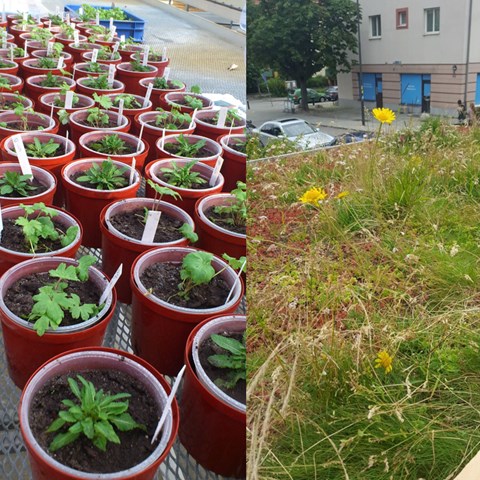Contact
Åsa Ode Sang, Professor at the Department of Landscape Architecture, Planning and Management
Phone: 040-41 54 38
E-mail: asa.sang@slu.se

We conduct socially relevant research and teaching in the fields of design, construction and management of vegetation, primarily in an urban context. We work to develop new concepts for the design, construction and management of attractive and functional nature-based solutions that contribute to sustainable urban development through the mitigation of climate change and the delivery of vital ecosystem services and functions, such as e.g. biodiversity, recreation, aesthetics, temperature regulation and stormwater management.
We are an interdisciplinary research group with disciplines such as horticulture, ecology, landscape architecture and forestry represented. Within the group we carry out research covering the spectrum of the design, construction and management of different type of vegetated systems. Our research can broadly be divided into the following strains, which often overlap in specific research projects:
The research makes use of opportunities for test beds at Campus Alnarp (in Alnarp Landscape Laboratory, SLU Horticulture laboratory and the park) as well as collaborative projects with for instance municipal stakeholders to ensure societal relevance and context. At the campus we use green houses, our indoor Urban Vegetation laboratory and the multi-sensoric lab SENSOLA to carry out experiment and perform analysis.
Research projects within Urban Vegetation
Members of the group carry out teaching primarily within the BSc programs Landscape Engineers and Garden Engineers design and the MSc program in Landscape Architecture.
Our teaching ranges from courses focusing on plant-material, habitats and soil-plant interactions, climate change adaptation to involvement in Landscape Architecture studio courses at BSc and MSc level.
In our teaching, we convey knowledge that is developed in our research, and make use of the internationally unique horticultural material and setting at Campus Alnarp.
Alnarp Urban Vegetation Lab
The Alnarp Urban Vegetation Lab includes indoor laboratory facilities which together with the plant material in the park, research fields and landscape laboratory facilitate a wide scope of research on urban vegetation.
Contact person: Anna Levinsson
Alnarp Landscape Laboratory
The landscape cannot be moved to a laboratory, thus a laboratory thinking need to be moved to the landscape. Guided by this notion, SLU and the Urban Vegetation group together with multiple partners have developed Europe’s first landscape laboratory. The landscape laboratory provides full-scale landscapes for research, teaching and demonstration of different approaches to vegetation design and management. This resource includes long-term projects as well as the possibility to establish new projects.
More information: The Alnarp Landscape Laboratory
Contact person: Björn Wiström
Theme Group Leader and Subject Leader Åsa Ode Sang:Ecosystem services, Nature-based solutions, Spatial analysis, Environmental aesthetics
Frida Andreasson: Carbon cycling, Ecosystem ecology, Green infrastructure, Plant-soil interaction, Urban soils
Ishi Buffam: Carbon cycling, Ecosystem services, Green infrastructure, Vegetated roofs, Climate change adaptation
Kamil Chojnowski
Tobias Emilsson: Climate change adaptation, Ecosystem services, Green infrastructure, Nature-based solutions, Plant-soil interactions, Tree physiology, Urban soils, Vegetated roofs
Anders Folkesson: Landscape design, Landscape construction, Biotope design, Planting design
Karin Ingemansson: Landscape design, Vegetation management, Multidisciplinary approach
Anna Levinsson
Barbara Mathiasson
Cecilia Palmér: Urban biodiversity, Vegetation management, Multidisciplinary approach
Henrik Sjöman
Stefan Sundblad: Planting design, Landscape design, Naturalistic planting design, Landscape construction, Design by management
Karin Svensson: Garden design, Planting design, Naturalistic planting design
Gebretsadik Melak Tamene: Urban street trees
Petra Thorpert: Landscape design, Multidisciplinary approach, Outdoor laboratories, Planting design, Urban biodiversity
Björn Wiström: Landscape laboratories, Urban forestry, Design by management, Naturalistic planting design, Vegetation management
Åsa Ode Sang, Professor at the Department of Landscape Architecture, Planning and Management
Phone: 040-41 54 38
E-mail: asa.sang@slu.se